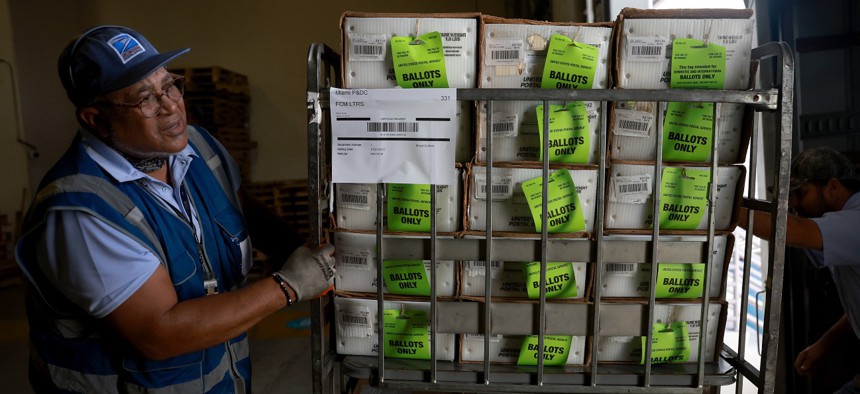
A U.S. Postal Service worker loads vote-by-mail ballots onto a truck at the Miami-Dade Election Department headquarters on July 21. Joe Raedle/Getty Images
The U.S. Postal Service Is Poised for Improved Performance in the 2022 Election, Officials Say
USPS has ramped up communications with local officials and will begin "extraordinary measures" to expedite ballot delivery next week.
The U.S. Postal Service is expressing confidence that tighter relationships between the mailing agency and state and local election officials have better prepared it for the upcoming midterm elections than the at times frantic experience in 2020.
USPS is just one week away from implementing the “extraordinary measures'' it instituted during the previous election, such as extra deliveries and collections, special pickups, expanded hours at processing plants, mail sorting plans to expedite ballot deliveries and the removal of some ballots to bypass normal processing to allow for local turnaround. Postal management agreed to continue taking those steps as part of a settlement agreement with the NAACP and Public Citizen last year and will leave them in place from Oct. 24 through Nov. 29.
USPS has established dedicated teams to focus on elections year-round, and those teams have spearheaded collaboration with stakeholders, postal unions, state and local election officials, the mailing industry, non-governmental organizations, Congress and other federal agencies. Postal officials have worked closely with election administrators to understand the vote-by-mail plans for every jurisdiction in the country, Adrienne Marshall, USPS’ election mail executive director, told reporters on Monday, providing guidance and helping to set expectations. The Postal Service sent its official election mail “kit” to each jurisdiction in March and is continuing to assist localities with mailpiece design and use of the election mail logo and other visibility tools.
While USPS experienced some disruptions earlier in 2020 from reforms Postmaster General Louis DeJoy implemented, employee unavailability due to the COVID-19 pandemic and legal disputes, the agency largely carried out a successful operation during the largest ever vote-by-mail election two years ago. During the 66 primary, special and runoff contests this year, USPS actually sped up its ballot delivery. The agency delivered 99.33% of ballots from voters to election officials within three days, Marshall said. As of July, USPS was seeing a nearly 200% increase in volume compared to the same point of the 2018 midterm season.
The Postal Service has already implemented trainings for field staff, daily “all clears” to ensure no ballots are left behind, log sheets for facilities to track election mail and a website for voters and election officials to report any problems. Its joint election task force, established with representatives from postal unions and associations, have ballot monitors and ambassadors who ensure the proper steps are being followed and that employees are aware of their responsibilities.
Eric Shen, inspector in charge at the U.S. Postal Inspection Service's criminal investigations group, said his agents have unique access to facilities and are reviewing physical security of election mail. All 16 of the service's field divisions have election mail security coordinators in place who have special training to handle election-related issues. He added collection boxes have been outfitted with security features to reduce any threats of mail theft.
“The Postal Inspection Service stands ready to defend against any attempts to disrupt the U.S. mail and to continue supporting the nation's most trusted institutions,” Shen said.
While some states and jurisdictions have sought to place restrictions on mail-in voting, often citing false claims of voter fraud, DeJoy this summer sought to quash any reservations about the system.
“I know election mail is safe,” he said. “And it'll continue to be safe because we pay a lot of attention to it.”
The election season will come with a considerable financial bump for the Postal Service. USPS saw between $30 million and $35 million in revenue just from ballots in 2020, Steve Monteith, the agency’s chief customer and marketing officer said, in addition to income from other election mail and political mailers. Monteith expressed confidence that network changes that DeJoy is implementing—many of which have not yet gone into effect—will not have any negative impact on the Postal Service’s ability to quickly deliver mail.
“Ultimately, we believe that will help us improve reliability for all of our customers, including election officials and voters,” Monteith said.
While a recent USPS inspector general report found the mailing agency was largely well-prepared to handle the upcoming election, it found many facilities were circumventing some of the steps required of them. Postal management agreed to reinforce its policies on all clears, sweeps and postmarking.







